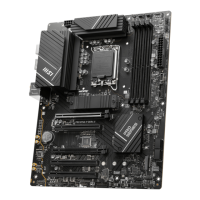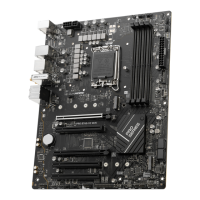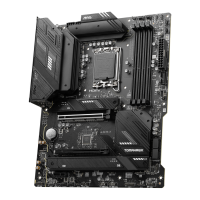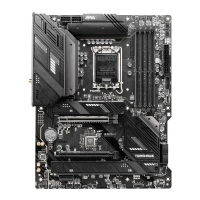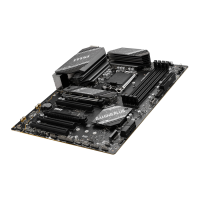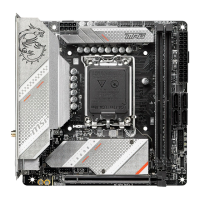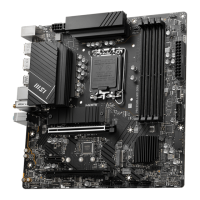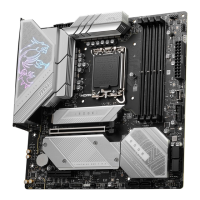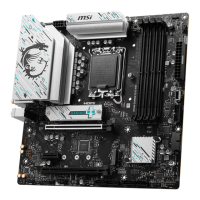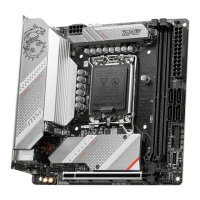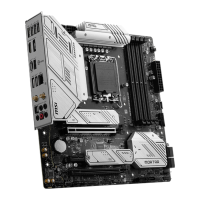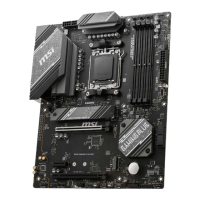Do you have a question about the MSI PRO B760-P WIFI and is the answer not in the manual?
Diagrams illustrating the necessary tools and components for PC assembly.
Details about supported CPUs, socket type, and compatibility.
Specifications for DDR5 memory slots, capacity, and speeds.
Details on the PCIe slots, their versions, and lane configurations.
Details on the M.2 slots, supported lengths, and interface types.
Overview of all ports available on the motherboard's rear I/O.
Features and functionalities related to the motherboard's BIOS.
Details on the MSI Center application for system optimization and control.
Features related to core boost, VRM power design, and dual CPU power.
Information on RGB LED connectors and Mystic Light features.
Diagram showing how to connect audio jacks to headphones and a microphone.
Diagram illustrating the connection of audio jacks to stereo speakers.
Explains the LGA1700 CPU, its notches, and the Pin 1 indicator for placement.
Guidance on installing memory modules for optimal dual-channel mode performance.
Step-by-step instructions for installing an M.2 SSD into the motherboard slot.
Instructions on connecting and enabling the chassis intrusion detection feature.
Procedure to reset the chassis intrusion warning from the BIOS.
Steps to clear CMOS memory and reset BIOS settings to their default values.
Instructions for safely removing and installing the CMOS battery.
Guide for connecting 5050 RGB LED strips to the JRGB connector.
Instructions for connecting RGB LED fans to the JRGB connector.
How to connect ARGB Gen2 LED strips using JARGB_V2 connectors.
Guide for connecting ARGB Gen2 LED fans to the JARGB_V2 connector.
Step-by-step guide for installing Windows 10 or Windows 11 operating systems.
Instructions on using the MSI utility to install necessary drivers and software.
Overview of the MSI Center application for system management and customization.
Benefits of UEFI over traditional BIOS, including faster booting and larger partition support.
Scenarios where UEFI might not be compatible, like 32-bit OS or older graphics cards.
Steps to verify if the system is operating in UEFI BIOS mode.
Instructions on how to access the BIOS setup menu during system startup.
Link to a detailed guide for understanding and configuring BIOS settings.
Guide to updating the motherboard's BIOS using the M-FLASH utility.
Instructions for updating the BIOS using the MSI Center software.
Statement regarding compliance with FCC rules for radio frequency interference.
Information about compliance with European Union directives for CE marking.
Disposal guidelines for batteries in the European Union.
MSI's commitment to product reuse, recycling, and environmental responsibility.
Diagrams illustrating the necessary tools and components for PC assembly.
Details about supported CPUs, socket type, and compatibility.
Specifications for DDR5 memory slots, capacity, and speeds.
Details on the PCIe slots, their versions, and lane configurations.
Details on the M.2 slots, supported lengths, and interface types.
Overview of all ports available on the motherboard's rear I/O.
Features and functionalities related to the motherboard's BIOS.
Details on the MSI Center application for system optimization and control.
Features related to core boost, VRM power design, and dual CPU power.
Information on RGB LED connectors and Mystic Light features.
Diagram showing how to connect audio jacks to headphones and a microphone.
Diagram illustrating the connection of audio jacks to stereo speakers.
Explains the LGA1700 CPU, its notches, and the Pin 1 indicator for placement.
Guidance on installing memory modules for optimal dual-channel mode performance.
Step-by-step instructions for installing an M.2 SSD into the motherboard slot.
Instructions on connecting and enabling the chassis intrusion detection feature.
Procedure to reset the chassis intrusion warning from the BIOS.
Steps to clear CMOS memory and reset BIOS settings to their default values.
Instructions for safely removing and installing the CMOS battery.
Guide for connecting 5050 RGB LED strips to the JRGB connector.
Instructions for connecting RGB LED fans to the JRGB connector.
How to connect ARGB Gen2 LED strips using JARGB_V2 connectors.
Guide for connecting ARGB Gen2 LED fans to the JARGB_V2 connector.
Step-by-step guide for installing Windows 10 or Windows 11 operating systems.
Instructions on using the MSI utility to install necessary drivers and software.
Overview of the MSI Center application for system management and customization.
Benefits of UEFI over traditional BIOS, including faster booting and larger partition support.
Scenarios where UEFI might not be compatible, like 32-bit OS or older graphics cards.
Steps to verify if the system is operating in UEFI BIOS mode.
Instructions on how to access the BIOS setup menu during system startup.
Link to a detailed guide for understanding and configuring BIOS settings.
Guide to updating the motherboard's BIOS using the M-FLASH utility.
Instructions for updating the BIOS using the MSI Center software.
Statement regarding compliance with FCC rules for radio frequency interference.
Information about compliance with European Union directives for CE marking.
Disposal guidelines for batteries in the European Union.
MSI's commitment to product reuse, recycling, and environmental responsibility.
| Processor socket | LGA 1700 |
|---|---|
| Processor manufacturer | Intel |
| Compatible processor series | Intel® Pentium® Gold |
| Maximum internal memory supported by processor | 192 GB |
| Memory channels | Dual-channel |
| Number of memory slots | 4 |
| Supported memory types | DDR5-SDRAM |
| Supported memory clock speeds | 6800, 6600, 6400, 6200, 6000, 5800, 5600, 5400, 5200, 5000, 4800 MHz |
| Supported memory clock speed (max) | 6800 MHz |
| Ethernet LAN | Yes |
| LAN controller | Realtek RTL8111H |
| Wi-Fi standards | 802.11a, 802.11ad, 802.11b, 802.11g, Wi-Fi 4 (802.11n), Wi-Fi 5 (802.11ac), Wi-Fi 6 (802.11ax) |
| Bluetooth version | 5.3 |
| Top Wi-Fi standard | Wi-Fi 6 (802.11ax) |
| Number of SATA III connectors | - |
| USB 3.2 Gen 1 (3.1 Gen 1) connectors | 2 |
| HDMI version | 1.4 |
| DVI-D ports quantity | 0 |
| USB 2.0 ports quantity | USB 2.0 ports have a data transmission speed of 480 Mbps, and are backwards compatible with USB 1.1 ports. You can connect all kinds of peripheral devices to them. |
| Ethernet LAN (RJ-45) ports | 1 |
| RAID levels | 0, 1, 5, 10 |
| Supported storage drive types | HDD & SSD |
| Supported storage drive interfaces | M.2, SATA |
| Package depth | 304.8 mm |
| Package width | 243.84 mm |
| Cables included | SATA |
| BIOS type | UEFI AMI |
| ACPI version | 6.4 |
| BIOS memory size | 256 Mbit |
| System Management BIOS (SMBIOS) version | 3.5 |
| Audio chip | Realtek ALC897 |
| Cooling type | Passive |
| Component for | PC |
| Motherboard chipset | Intel B760 |
| Audio output channels | 7.1 channels |
| Motherboard form factor | ATX |
| Windows operating systems supported | Windows 10 x64, Windows 11 x64 |
